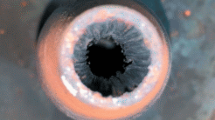Abstract
The results of studies into geometric characteristics for multistage steam jet ejectors are presented. Various manufacturers’ approaches during multistage ejector design optimization are analyzed accounting for the pressure increase levels’ distribution and the nozzles’ critical diameters of the ejector stages. It was found that, for cogeneration and condensing turbines, an approach to the distribution of geometric and technological parameters over the ejector stages can vary. For cogeneration turbines, the diameters of the nozzles’ critical sections decrease with an increase of stage number, while they increase for condensing turbines. It is shown that there is a correlation in multistage ejectors between the distribution of steam flow rates between stages and the main geometric parameter of the ejector’s first stage. The test results of three- and two-stage ejectors with external coolers designed by the authors are presented. The main three-stage ejector is employed in the scheme of steam-air mixture evacuation from the turbine condenser, and the two-stage ejector with a precooler is designed to evacuate air from the scheme of the turbine heat extraction plant. The ejector of the heat extraction plant is connected to the main condensate line behind the main ejectors. Steam condensate is removed from the ejector to the hot well of the first delivery water heater. Multistage ejectors are equipped with an extended scheme for pressure measuring along the ejector’ steam-air mixture path: in the intake chamber, after the diffuser, and in the intermediate cooler. It is shown that an increase in the pressure of the steam-air mixture, which cannot be explained by the obvious diffuser effect, that is, by the pressure increase as flow decelerates, is observed in the ejectors’ coolers (between the stage diffuser and the intake chamber of the next stage). When analyzing the operating modes of multistage ejectors, the spesific feature of their self-regulation is revealed with the possibility of decreasing the steam-air mixture compression ratio in one of the stages.








Similar content being viewed by others
REFERENCES
G. Besagni, “Ejectors on the cutting edge: The past, the present and the perspective,” Energy 170, 998–1003 (2019). https://doi.org/10.1016/j.energy.2018.12.214
E. Ya. Sokolov and N. M. Zinger, Jet Devices (Energoatomizdat, Moscow, 1989) [in Russian].
V. S. Baikov and Yu. N. Vasil’ev, “Comparison of limit theoretical characteristics of supersonic gas ejectors with isobaric and cylindrical mixing chambers,” Uch. Zap. TsAGI 14 (5), 47–57 (1983).
G. G. Shklover and O. O. Mil’man, Study and Calculation of Condensation Units of Steam Turbines (Energoatomizdat, Moscow, 1985) [in Russian].
RD 34.30.105. Procedural Guidelines for Calculation and Design of Steam-Jet Ejectors for Condensation Units of Turbines at Thermal and Nuclear Power Plants (Minenergo SSSR, Moscow, 1985).
D. V. Brezgin, K. E. Aronson, F. Mazzelli, and A. Milazzo, “The surface roughness effect on the performance of supersonic ejectors,” Thermophys. Aeromech. 24, 553–561 (2017). https://doi.org/10.1134/S0869864317040060
K. E. Aronson, I. B. Murmanskii, D. V. Brezgin, A. Yu. Ryabchikov, A. A. Chubarov, and Yu. M. Brodov, “Computer software package "Design and verification calculation of steam jet ejectors”,” RF Software Registration Certificate No. 2016611885 (2016).
Yu. M. Brodov, V. K. Kuptsov, A. Yu. Ryabchikov, K. E. Aronson, I. B. Murmanskii, N. V. Zhelonkin, D. V. Brezgin, and S. I. Khaet, “Jet apparatus with variable axial distance between nozzle and mixing chamber,” RF Patent No. 2645635, MPK F04F 5/30 (2006.01), Byull. Izobret., No. 6 (2018).
K. E. Aronson, M. V. Bodanin, D. V. Brezgin, A. L. Demidov, I. Yu. Dubov, N. V. Zhelonkin, V. K. Kuptsov, Yu. V. Makhnev, A. Yu. Ryabchikov, and K. A. Tarov, “Steam-jet ejector,” RF Patent No. 203733, MPK F04F 5/22 (2006.01), Byull. Izobret., No. 11 (2021).
Yu. M. Brodov, Increasing Efficiency and Reliability of Heat Exchange Apparatuses of Steam Turbine Plants, 4th ed. (Ural. Izd.-Poligr. Tsentr, Yekaterinburg, 2012) [in Russian].
K. E. Aronson, A. Yu. Ryabchikov, D. V. Brezgin, N. V. Zhelonkin, A. L. Demidov, D. Yu. Balakin, Yu. V. Makhnev, and K. A. Tarov, “Modernizing the scheme of suction of non-condensable gases from heating water heaters of cogeneration turbines,” Elektr. Stn., No. 7, 9–14 (2022).
K. E. Aronson, M. V. Bodanin, D. V. Brezgin, A. L. Demidov, I. Yu. Dubov, N. V. Zhelonkin, Yu. V. Makhnev, A. Yu. Ryabchikov, K. A. Tarov, and V. M. Fraifel’d, “Steam turbine cogeneration plant,” RF Patent No. 2766653, MPK F01K 17/02 (2006.01), Byull. Izobret., No. 18 (2022).
K. E. Aronson, A. L. Demidov, N. V. Zhelonkin, I. B. Murmanskii, and A. Yu. Ryabchikov, “Flow meter of steam turbine vacuum system,” Turbiny Dizeli, No. 1 (88), 60–62 (2020).
A. S. Zhikharev and Yu. S. Mantrova, “Influence of velocity on the efficiency of droplet separation during partial condensation of steam in a tube bundle,” Izv. MGTU MAMI 3 (3), 49–53 (2014).
G. N. Abramovich, Applied Gas Dynamics (Nauka, Moscow, 1991; Defense Technical Information Center, Ft. Belvoir, 1973).
A. G. Shempelev, “Development and approbation of methodology aimed to define the reasons for turbine unit capacity limitation based on the specified mathematical model of its condenser,” Probl. Reg. Energ. 4, 79–87 (2021). https://doi.org/10.52254/1857-0070.2021.4-52.08
G. G. Shklover, “Calculation of steam-jet ejector taking into account steam condensation in the intercooling device,” Energomashinostroenie, No. 12, 19–21 (1968).
L. D. Berman and S. N. Fuks, “Calculation of surface heat exchange apparatuses for steam condensation from steam–air mixture,” Teploenergetika, No. 7, 74–84 (1959).
K. E. Aronson, A. Yu. Ryabchikov, Yu. M. Brodov, D. V. Brezgin, N. V. Zhelonkin, and I. B. Murmanskii, “Analysis of experimental characteristics of multistage steam-jet electors of steam turbines,” Therm. Eng. 64, 104–110 (2017). https://doi.org/10.1134/S0040601517020021
Author information
Authors and Affiliations
Corresponding author
Rights and permissions
About this article
Cite this article
Aronson, K.E., Ryabchikov, A.Y., Zhelonkin, N.V. et al. Features of the Development and Operation of Multistage Steam Jet Ejectors. Therm. Eng. 70, 245–253 (2023). https://doi.org/10.1134/S0040601523040018
Received:
Revised:
Accepted:
Published:
Issue Date:
DOI: https://doi.org/10.1134/S0040601523040018



